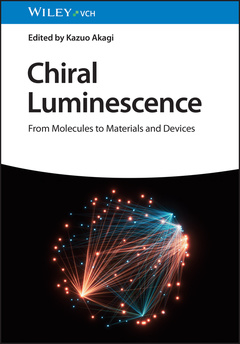Chiral Luminescence, 2 Volumes From Molecules to Materials and Devices
Coordonnateur : Akagi Kazuo

Comprehensive resource illustrating the latest stage and development of chiral luminescence in science and technology, from fundamentals to applications
Chiral Luminescence imparts a comprehensive understanding for chiral materials bearing circularly polarized luminescence (CPL) functions, including molecules, oligomers, polymers, chiral metal organic complexes, and chiral biochemical materials, with guidance on how to promote and control this kind of luminescence towards the development of advanced photonic materials and devices such as chiroptical and electronic devices, next-generation displays, and others.
The book covers detailed information on the molecular design, synthesis, and polymerization methods of chiral luminescent materials, the evaluation of chiroptical properties represented by CPL, novel spectroscopic instruments and techniques, the fabrication of chiral luminescent devices such CPL-OLED, a theoretical evaluation, and potential applications.
With insight from leading academics and industrial researchers in the field, Chiral Luminescence includes information on:
- Optical resolution and chiroptical properties of partially overlapping carbazolophanes and developments in CPL research using cyclodextrins
- Synthesis and chiroptical properties of helical, conjugated polymers and twisted molecules, and chiroptical and magnetooptical properties of porphyrin compounds
- Principles of CPL measurement systems and advances in measurement methods, and intense and sign-invertible CPL
- Development of organic light-emitting diodes using aggregation-induced enhanced CPL perylene diimides
- Binding constants as fundamental physical properties for quantitative treatments of sensing processes in supramolecular systems
Providing far-reaching coverage of chiral luminescence and its many applications, Chiral Luminescence is a must-read resource for a variety of chemists and engineers who wish to understand the state-of-the-art development in this optical science.
VOLUME 1:
Section I Molecules
01 Synthesis and Properties of Circularly Polarized Luminescence-Active Molecules based on Binaphthyl Skeleton
02 An Approach for the Qualitative Understanding of Electronic and Magnetic Transition Moments Aiming at the Design of CPL Chromophore Having Enhanced Chiroptical Properties
03 Optical Resolution and Chiroptical Properties of Partially-Overlapped Carbazolophanes
04 Circularly Polarized Luminescence in Stereogenic Pi-Conjugated Macrocycles
05 Developments in Circularly Polarized Luminescence Research Employing Cyclodextrins
06 Circularly Polarized Luminescence based on Chiral AIEgens
07 Planar Chiral [2.2]Paracyclophane: Excellent Circularly Polarized Luminescence Emitters
08 Nanometrical Helical Structures as Platform to Induce Chiroptical Properties to Achiral Components
Section II Oligomers and Polymers
09 Synthesis and Chiroptical Properties of Helically Stacked Conjugated Polymers
10 Synthesis and Chiroptical Properties of Helical, Conjugated Polymers, and Twisted Molecules
11 Chiroptical and Magneto-optical Properties of Porphyrin Compounds
12 CPL Emission from The Photo-Excited Parallel-Oriented Aryl/Aryl Dimer
13 Synthesis, Control of Higher-Order Structures, and Optical Properties of Platinum-Containing Poly(aryleneethynylene)s and Related Compounds
14 Chiroptical Supramolecular Assemblies
15 Circularly Polarized Luminescence (CPL) in Helically Assembled Pyrene Pi-Stacks on RNA Duplex
16 Circularly Polarized Luminescence of Helical Network Polymers Synthesized in Chiral Liquid Crystals
17 Ultraweak Intermolecular Interactions in Chirogenesis from Non-Charged CPL-/CD- Silent Molecules, Oligomers, and Polymers Endowed with Noncharged Chiral Terpenes, Mono-/Polysaccharides, and Helical Polysilanes
Section III Coordination Compounds
18 Circularly Polarized Luminescence Induced by an External Magnetic Field: Magnetic Circularly Polarized Luminescence
19 Phosphorescent Organometallic Complexes Aimed at Fabrication of Electroluminescent Devices
VOLUME 2:
20 Enhancement of Circularly Polarized Luminescence in the Condensed Molecules and Coordination Complexes
21 Control of the Emission and Chiroptical Properties of Helicene Derivatives
22 Recent Advances on CP-OLEDs and CPL-Active Materials of Chiral Metal-Containing Complexes
23 Evolving Fluorophores into Circularly Polarized Luminophores with Chiral Naphthalene Dimers and Tetramers
24 Polarized Luminescence of Lanthanide Coordination Compounds
25 CPL in Chiral Metal Nanoclusters
26 Circularly Polarized Luminescence Chromophores Based on Metal Complexes
Section IV Theory and Spectroscopy
27 Recent Advancement of Circularly Polarized Luminescence of Helicenes
28 Systematic Investigation on CPL Properties of Various Chiral Motifs through Theoretical Calculation
29 Principles of CPL Measurement Systems and Advances in Measurement Methods
30 Using Chiroptical Spectroscopy to Gain Unique Information about the Solid-State
31 Circularly Polarized Luminescence for Molecular Systems of Increasing Complexity
32 Luminescence and CPL Spectra of d10 Metal Complexes
Section V Devices for Application
33 Development of Organic Light-Emitting Diodes using Aggregation-Induced Enhanced Circularly Polarized Luminescent Perylene Diimides
34 Chiroptical Properties Enhancement of Chiral Eu(III) Complex in Association with Ionic Materials such as DNA Toward Device Application
35 Circularly Polarized Luminescence Materials and Their Organic Light-emitting Device Performances
36 Intense and Sign-Invertible Circularly Polarized Luminescence
37 Direct Emission of Circularly Polarized Light from Twisted Structure of Mesogenic Luminophores and
Improvement of OLEDs
38 Binding Constants as Fundamental Physical Properties for Quantitative Treatments of Sensing Processes in Supramolecular Systems
Kazuo Akagi is an Eminent Research Professor, Research Organization of Science and Technology at Ritsumeikan University in Shiga, Japan, and a Professor Emeritus of Kyoto University and University of Tsukuba, Japan. After graduating from Kyoto University, he spent most of his career working for University of Tsukuba and Kyoto University before taking up his present appointment at Ritsumeikan University. Professor Akagi has received numerous scientific awards, including The Chemical Society of Japan (CSJ) Award.
Date de parution : 04-2024
17x24.4 cm



